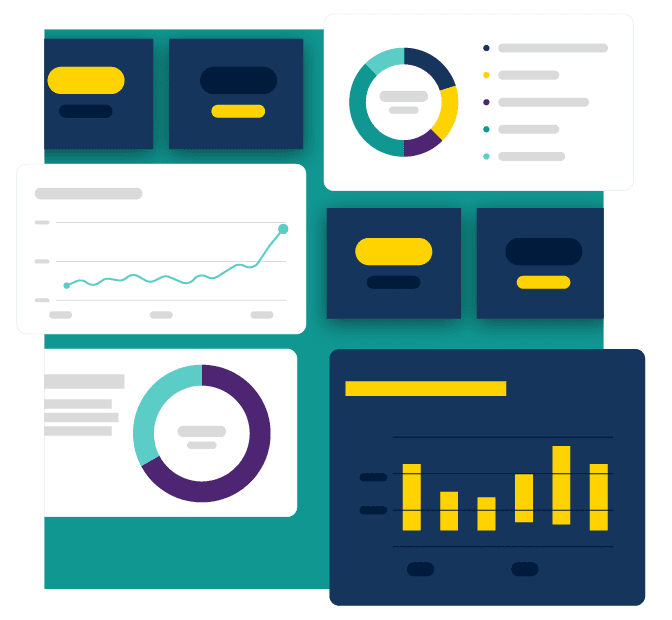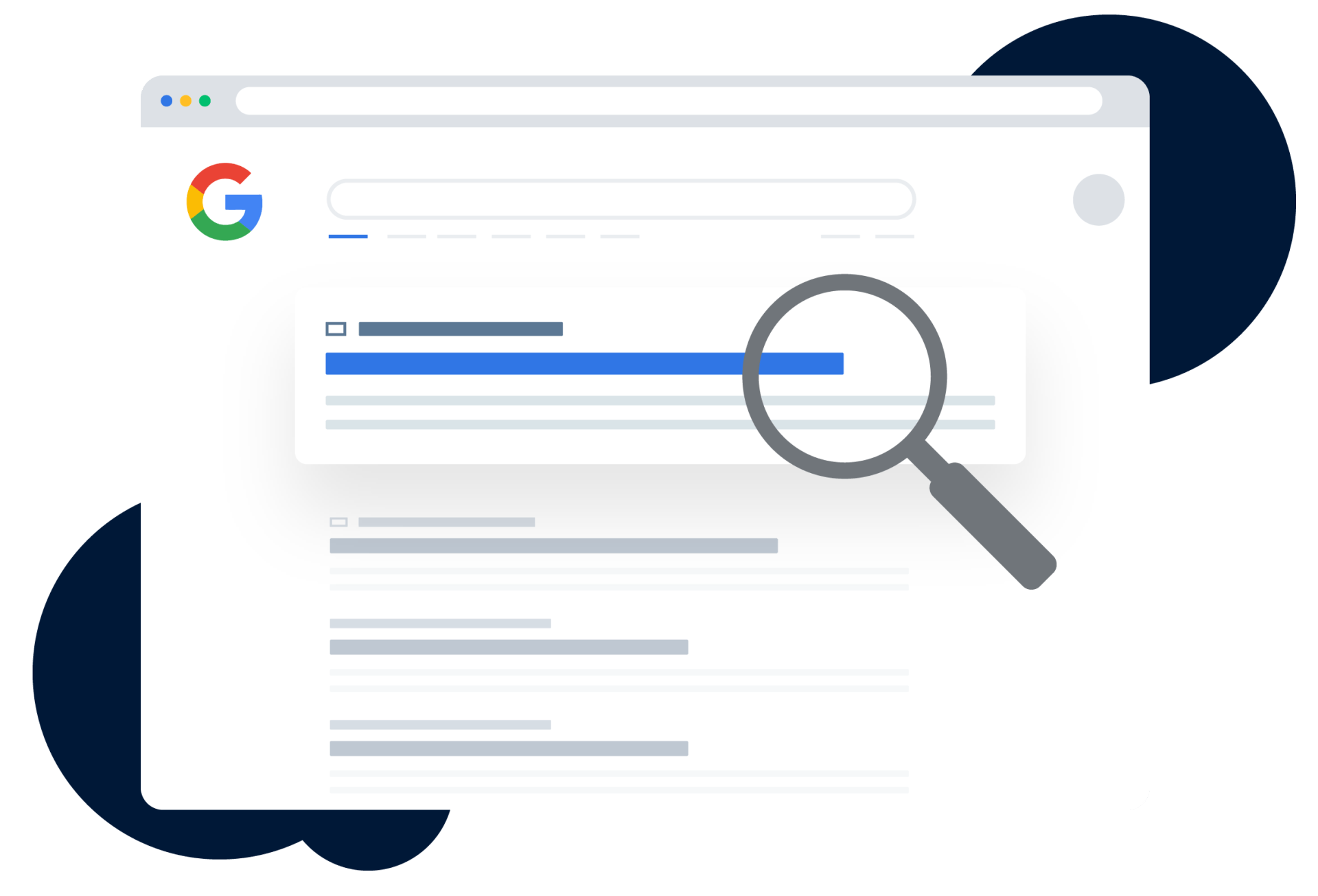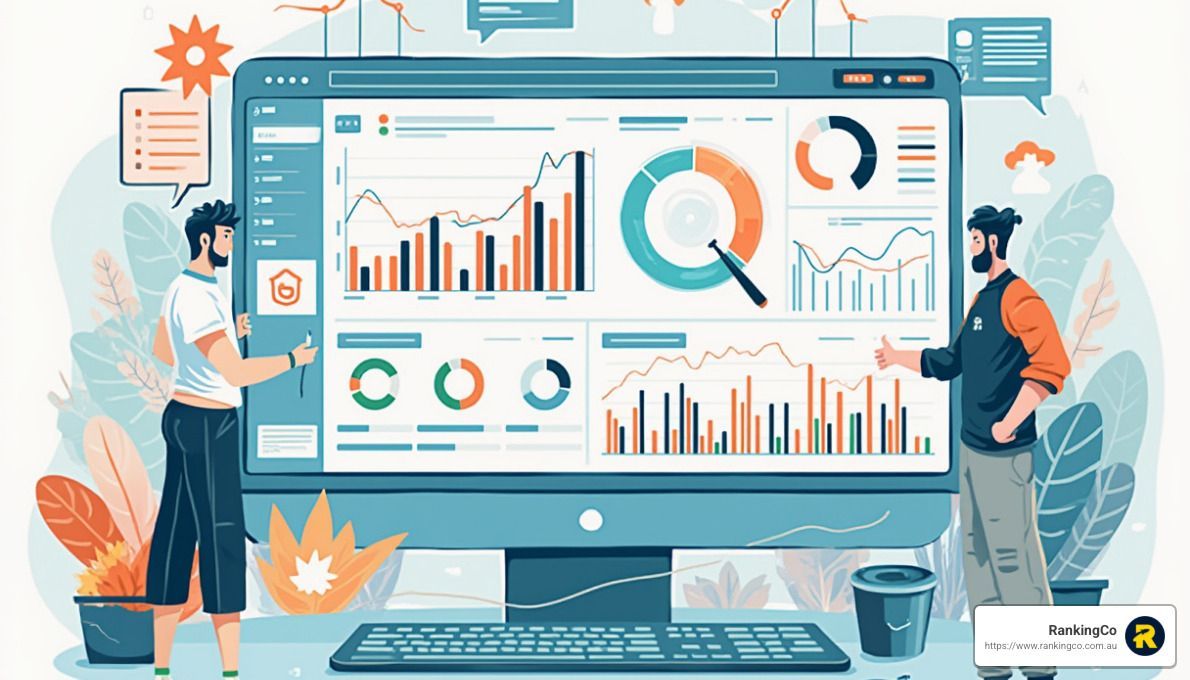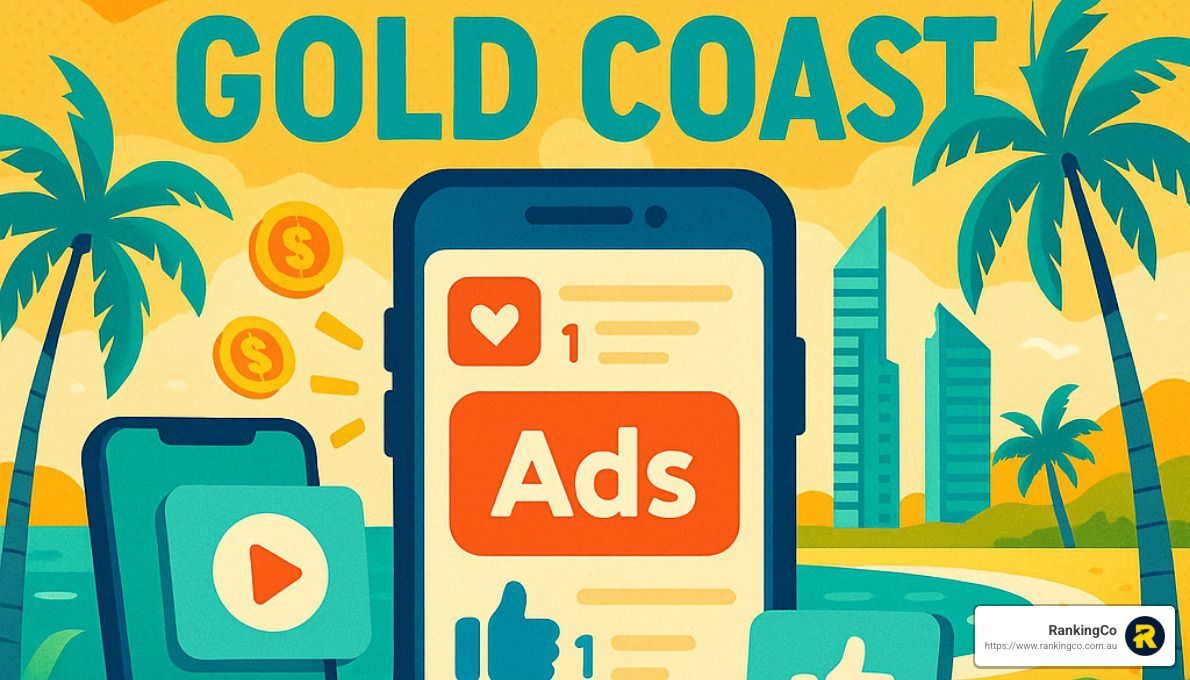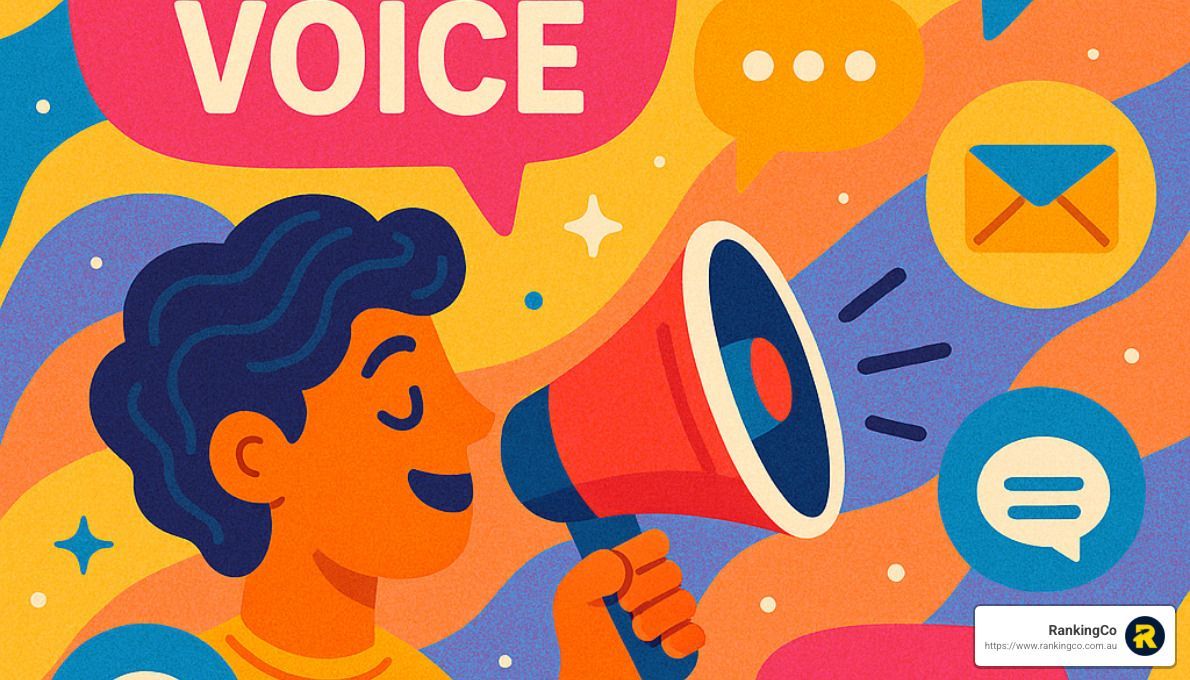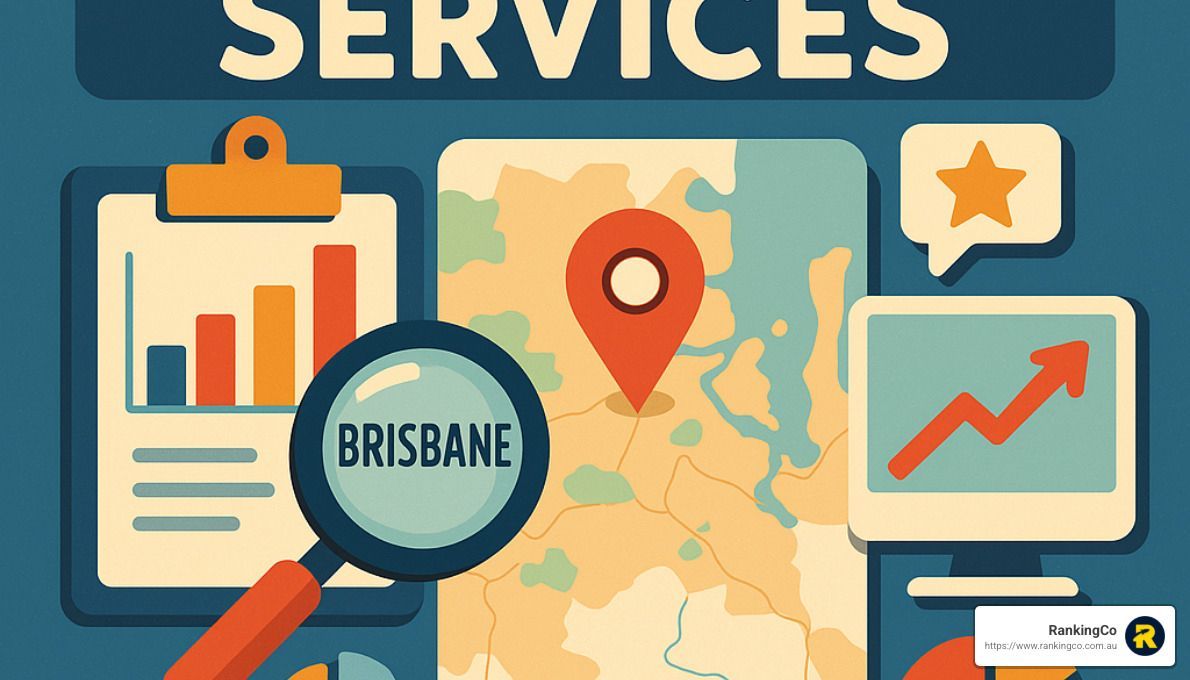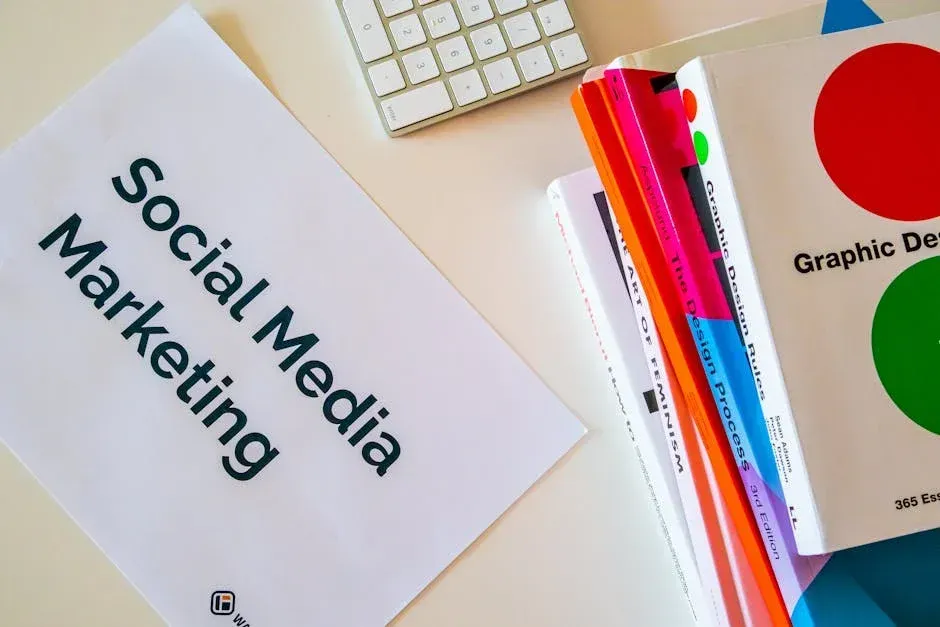An Essential Guide to Understanding Marketing Fatigue
When Your Marketing Stops Working: Understanding Fatigue
Marketing fatigue occurs when consumers become overwhelmed by excessive marketing messages, causing them to tune out, unsubscribe, or actively avoid brand communications. This phenomenon affects both consumers and businesses, leading to wasted resources and diminished returns.
"I'm as mad as hell, and I'm not going to take this anymore!" - from the movie 'Network'
This famous quote perfectly captures how many consumers feel about the barrage of marketing messages they receive daily.
What is Marketing Fatigue?
Research shows that 66% of consumers want fewer marketing messages, while 27% feel bombarded by the sheer volume they receive. Even more concerning, 81% of consumers are ready to cut ties with brands that overwhelm them with marketing communications.
Marketing fatigue doesn't just affect your audience—it impacts your team too. When marketers continuously push out content without clear strategy or measurement, creativity suffers and campaigns become less effective.
The average person is exposed to approximately 5,000 ads per day, and human attention spans have decreased from 2.5 minutes in 2003 to just 47 seconds today, according to research from the American Psychological Association. In this environment, standing out requires more than just increasing message frequency—it demands relevance and value.
I'm Amber Porter, CEO of RankingCo, and throughout my career, I've helped countless businesses identify and overcome marketing fatigue by creating strategies that cut through the noise rather than contributing to it.
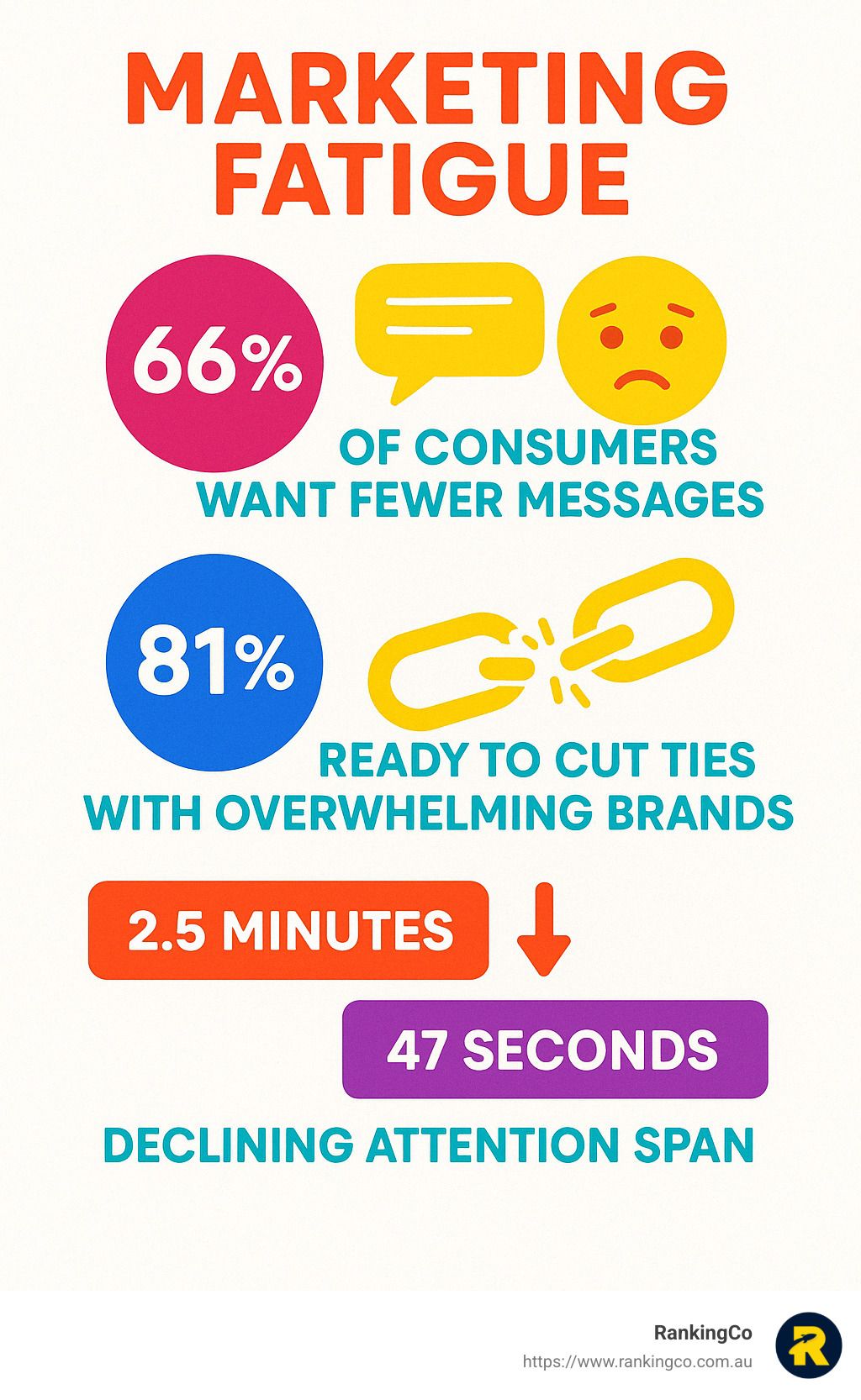
What is Marketing Fatigue?
Marketing fatigue is that all-too-familiar feeling when your audience mentally checks out from your marketing messages. It's like when you're at a party and someone keeps telling the same story – eventually, you just stop listening. In the digital world, your audience develops this same selective hearing when bombarded with too many similar messages.
This isn't simply about message quantity (though that certainly plays a role). It's about the cumulative effect when consumers feel overwhelmed by content that seems irrelevant, repetitive, or intrusive across multiple channels simultaneously.
Interestingly, research published in the Journal of Advertising suggests that marketing fatigue relates more to the mental effort required to process messages rather than just the sheer number received. When your audience needs to work hard to determine if your message matters to them, fatigue sets in much faster.
As marketing expert Tom Bacon aptly puts it, "Customer fatigue—a normal response to too many email offers—is deadly for e-merchandisers!" And this principle extends well beyond email to every marketing channel you're using.
Signs of Marketing Fatigue in Your Audience
Spotting marketing fatigue in your audience early can save your campaigns before permanent damage occurs. Watch for these telling indicators:
When your email open rates start trending downward consistently, it's often the first sign that recipients are becoming more selective about which messages deserve their attention. Even more telling is when your click-through rates decline – this shows that even when people do open your communications, they're not finding the content compelling enough to take action.
A sudden spike in unsubscribes is perhaps the clearest warning signal. Research indicates that a whopping 70% of consumers have unsubscribed from brands in the last three months simply because they felt overwhelmed by message volume.
On social media, decreasing engagement (fewer likes, comments, and shares) suggests your content is no longer resonating. When users actively mark your messages as spam, they're essentially shouting that your communications feel intrusive rather than valuable.
The ultimate impact? Diminishing conversion rates. After all, if people aren't engaging, they certainly aren't buying. Changes in user behaviour – like spending less time on your site or viewing fewer pages per visit – can also indicate growing disinterest.
These symptoms rarely occur in isolation. One Brisbane retailer we worked with noticed their declining social media engagement coincided perfectly with increased unsubscribe rates and plummeting conversions – the classic trifecta of audience fatigue.
Signs of Marketing Fatigue in Your Marketing Team
While most discussions about marketing fatigue focus on consumer reactions, it's equally important to recognise when your own marketing team is burning out. When your team suffers from fatigue, the quality of your marketing inevitably suffers too, creating a vicious cycle that accelerates audience disengagement.
Watch for content burnout – that moment when your team struggles to generate fresh ideas or simply recycles old concepts with minimal changes. You might notice a decline in creativity and innovation as novel approaches give way to "safe" but uninspiring content because team members lack the energy to push boundaries.
Campaign performance often plateaus as your team goes through the motions without strategic thinking, resulting in campaigns that maintain the status quo rather than driving growth. Staff morale issues – increased absenteeism, higher turnover, and reduced participation in brainstorming – can all signal team fatigue.
Quality control may slip as deadlines are consistently missed, indicating an overwhelmed team. Perhaps most telling is when team members stop celebrating wins or analysing failures – they may simply be too exhausted to care.
At RankingCo, we've observed this pattern repeatedly with clients who came to us after attempting to manage too many marketing channels in-house. One Brisbane-based e-commerce company was posting daily across six social platforms, sending bi-weekly emails, and managing Google Ads campaigns—all with just a two-person marketing team. The predictable result? Mediocre content, declining engagement, and a team ready to hand in their resignation letters.
Common Causes of Marketing Fatigue
Ever feel like your marketing efforts are spinning wheels rather than gaining traction? You're not alone. Marketing fatigue is becoming increasingly common in our hyper-connected world, and understanding what causes it is the first step toward fixing it.
Think of marketing fatigue like overtraining in fitness – push too hard without proper recovery, and performance actually declines rather than improves. The same principle applies to your marketing strategy.
From our experience working with businesses across Australia, we've identified several key culprits behind marketing exhaustion:
Too many platforms is perhaps the most common issue we see. Many businesses feel pressured to maintain a presence on every social channel, email platform, and advertising network simultaneously. This "spray and pray" approach typically results in mediocre performance everywhere rather than excellence anywhere.
Overcommunication is another major offender. When brands prioritise frequency over quality, they risk turning their audience off completely. One Brisbane retailer we worked with was sending identical promotional messages across email, SMS, and multiple social platforms—sometimes all on the same day! Their unsubscribe rates were through the roof while conversions plummeted.
Without clear goals, marketing efforts become scattered and excessive. Teams end up creating content simply to fill a calendar rather than to achieve specific objectives. This aimless approach wastes resources and accelerates fatigue for both audiences and marketing teams.
Repetitive content quickly leads to audience disengagement. If you're recycling the same messages across different channels without adding fresh value, you're training your audience to ignore you.
Poor targeting might be the most wasteful cause of all. Broad, untargeted campaigns reach many but resonate with few, creating noise rather than meaningful connections.
Overwhelming Message Volume and Frequency
The numbers are staggering: the average person is exposed to approximately 5,000 ads daily. With human attention spans shrinking from 2.5 minutes in 2003 to just 47 seconds today, marketers face an uphill battle for consumer attention.
This cognitive overload creates real psychological effects. The Zeigarnik Effect, where unfinished tasks create mental tension, means that each marketing message demanding attention becomes another unfinished cognitive task, contributing to overall stress and fatigue.
Research from the American Psychological Association shows that constant task-switching—like checking notifications from multiple marketing channels—can reduce productivity by up to 40% and increase stress levels significantly. This helps explain why consumers become increasingly resistant to marketing messages over time.
What's particularly interesting is that there's an optimal threshold for message frequency. While the first few exposures to a marketing message typically drive engagement and sales, there's a tipping point where additional messages become counterproductive. For some audience segments, this might be around the tenth exposure, but it varies significantly based on industry, channel, and audience demographics.
A revealing statistic that challenges conventional marketing wisdom: 61% of consumers report that frequent ads from a brand actually decrease the likelihood they'll purchase from that company. More isn't always better.
At RankingCo, we've found that implementing frequency capping in Google Ads campaigns can significantly improve both performance and cost-efficiency. By limiting how often the same user sees an ad, we prevent ad fatigue while maintaining visibility among new potential customers.
Lack of Personalisation and Relevance
In today's marketing landscape, generic, one-size-fits-all messaging is perhaps the quickest route to marketing fatigue. When your communications lack personalisation, they require more cognitive effort from recipients to determine value—and most won't bother making that effort.
The numbers tell a compelling story: 81% of consumers are likely to open emails when the content is customised to their interests. Furthermore, 67% are more likely to purchase when recommendations reflect their past behaviour. These aren't small margins—they represent the difference between marketing that works and marketing that exhausts.
One Melbourne retailer we worked with was sending identical promotional emails to their entire database regardless of purchase history or engagement patterns. It's a common approach, but one that quickly leads to diminishing returns. After implementing basic segmentation strategies through our Content Strategies for Social Media approach, they saw open rates increase by 32% and conversion rates by 28%—simply by making their messages more relevant to specific audience segments.
The challenge for marketers is striking the right balance between personalisation and privacy. While consumers expect relevant content, they're increasingly concerned about how their data is collected and used. According to recent studies, 59% of consumers are comfortable with brands using AI for personalisation, but only when it's transparent and provides genuine value.
What we're seeing is a fundamental shift in how consumers view marketing communications. Irrelevant messages aren't just ignored—they actively damage brand perception. Many consumers report developing negative feelings toward brands that consistently send communications that don't align with their interests or needs.
Think of it this way: if every conversation with a friend centred around topics you had no interest in, you'd eventually stop taking their calls. The same principle applies to your marketing relationships.
Measuring Marketing Fatigue: Metrics to Monitor
When you're too close to your marketing efforts, it can be hard to spot when things aren't working anymore. That's why having concrete data to identify marketing fatigue is so essential—it gives you an objective view of what's really happening with your audience.
Think of these metrics as your early warning system. They'll help you spot trouble before your campaigns crash and burn completely.
Engagement metrics tell the most immediate story. When your once-active audience stops liking, sharing, and commenting on your social posts, they're sending you a clear message: something's off. Similarly, declining email open rates suggest your subject lines no longer spark curiosity—or worse, your audience has mentally filed you under "ignore."
Click-through rates are perhaps the most telling indicator. After all, if someone opens your email but doesn't click on anything, they found nothing compelling enough to act on. As one of our Brisbane clients finded, their CTR had dropped from 4.2% to just 0.8% over three months—a clear signal their audience had grown weary of their messaging.
Conversion rates reveal the bottom-line impact. When people stop taking the actions you want them to take—whether that's making purchases, signing up for webinars, or downloading resources—marketing fatigue is likely affecting your revenue directly.
Time-based analysis adds another critical dimension. By tracking how engagement changes relative to message frequency, you can identify your audience's tolerance threshold. We've found that plotting engagement against frequency often reveals a clear tipping point where additional messages become counterproductive.
Of course, when people actively opt out—through unsubscribes, unfollows, or muting—they're explicitly telling you they've had enough. A sudden spike in these metrics demands immediate attention.
At RankingCo, we implement comprehensive tracking for all our Digital Marketing Services in Brisbane clients. This vigilance helps us catch the early signs of fatigue before they significantly impact campaign performance and brand perception.
Identifying Signs Through Data
The real power in measuring marketing fatigue comes not just from watching individual metrics but from connecting the dots between different data points to reveal the full picture.
Start by establishing your normal baseline performance. What's a typical open rate for your emails? How many comments do your social posts usually get? What's your average conversion rate from specific campaign types? Without these benchmarks, you won't be able to recognise when things start slipping.
Next, look for patterns that tell a story. For instance, we worked with a Gold Coast retailer who couldn't understand why their sales were dropping despite increasing their marketing efforts. When we analysed their data, we found a clear correlation: after customers received more than five emails in two weeks, their engagement dropped dramatically. The more messages they sent, the worse their results became—a classic sign of marketing fatigue.
Different audience segments often show fatigue at different rates. Your loyal customers might welcome frequent updates, while new prospects could be easily overwhelmed. Breaking down your metrics by segment often reveals which groups are most sensitive to high-frequency messaging.
Similarly, channel-specific analysis is crucial. Your audience might be perfectly happy with daily Instagram stories but find three emails a week excessive. Understanding these nuances helps you optimise each channel independently.
A/B testing is particularly valuable for identifying fatigue thresholds. By systematically testing different frequencies and content types, you can determine the sweet spot for your specific audience. One of our e-commerce clients finded through testing that sending emails twice weekly (rather than their previous daily schedule) actually increased their overall monthly revenue by 28%.
Cohort analysis adds another layer of insight by tracking how engagement changes throughout the customer lifecycle. New customers often have different tolerance levels than long-term ones, and understanding these patterns helps you tailor your approach accordingly.
The Impact on ROI and Brand Reputation
When marketing fatigue sets in, the consequences go far beyond annoying your audience—they hit your bottom line and can damage your brand for the long term.
From a pure ROI perspective, fatigued audiences simply convert less. Your cost-per-acquisition climbs as you need to reach more people to achieve the same results. It's like trying to fill a bucket with a hole in it—you're pouring in more resources but getting diminishing returns.
I remember working with a Brisbane fashion retailer who had doubled their ad spend but saw conversions increase by only 12%. When we dug into the data, we finded they were showing the same ads to the same audience segments up to 15 times per week. Their audience wasn't responding to more exposure—they were actively tuning it out.
The wasted marketing spend can be substantial. One study found that businesses waste approximately 26% of their marketing budget on ineffective channels and tactics, with excessive frequency being a major culprit. That's real money that could be invested in more productive strategies.
Beyond immediate financial impacts, marketing fatigue erodes something even more valuable: your brand reputation. In today's connected world, consumers don't just silently disengage—they share their frustrations. We've seen clients face public complaints about being "spammy" or "pushy" when their messaging frequency crossed the line.
This reputation damage has lasting effects. Research shows that 81% of consumers are ready to cut ties with brands that overwhelm them with marketing messages. Even more concerning, 39% will actively discourage friends and family from engaging with brands that bombard them with irrelevant communications.
Customer loyalty suffers too. When existing customers feel harassed rather than valued, their lifetime value decreases dramatically. One retail client we worked with saw their customer retention rate drop by 18% during a period of aggressive marketing—a costly mistake in an era where keeping existing customers is far more cost-effective than acquiring new ones.
The good news is that these negative impacts are reversible with the right approach. After implementing our fatigue management strategies for that same retailer—including better segmentation, frequency capping, and content diversification—they not only stopped the exodus of customers but saw a 22% increase in average order value from their email campaigns.
The lesson is clear: sometimes doing less, but doing it better, yields far greater returns than simply doing more.
Strategies to Combat Marketing Fatigue

When your marketing stops delivering results, it's not always about doing more—it's about doing better. Let's explore how to refresh your approach and reconnect with your audience in meaningful ways.
Refine Your Marketing Goals and Objectives
The journey to overcoming marketing fatigue begins with clarity. Without well-defined goals, marketing efforts often drift into the dangerous territory of "more is better"—the very approach that exhausts your audience.
Take a step back and ask yourself what you're truly trying to achieve. Are you looking to build brand awareness, generate qualified leads, or drive direct sales? Each goal requires a different approach and cadence.
I recently worked with a Brisbane accountancy firm that was posting daily across multiple platforms yet struggling to generate meaningful engagement. When we drilled down to their actual business needs—attracting high-value business clients in the local area—we finded most of their social content wasn't aligned with this goal at all. By refocusing their efforts specifically on LinkedIn with targeted content about business tax strategies, they reduced their overall posting volume by 60% while doubling their qualified leads.
Quality over quantity isn't just a catchy phrase—it's the antidote to marketing fatigue. When every piece of content serves a clear purpose, you need less of it to achieve better results.
For more guidance on aligning your marketing activities with business objectives, our guide on Effective Digital Marketing Strategies offers practical frameworks to help you cut through the noise.
Segment and Personalise Your Audience
Nothing accelerates marketing fatigue faster than irrelevant messages. Think about your own experience—don't you tune out when brands send you offers that have nothing to do with your interests or needs?
Modern consumers expect personalisation, not just as a nice-to-have but as a baseline requirement. In fact, 81% of consumers are more likely to open emails when the content matches their specific interests.
At RankingCo, we've seen remarkable changes when clients shift from broadcast-style marketing to targeted approaches. One local retailer was sending identical promotional emails to their entire database twice weekly. By implementing basic behavioural segmentation—separating recent purchasers from inactive customers, for instance—they saw their open rates climb from 12% to 29%, while actually sending fewer total emails.
Effective segmentation doesn't need to be complex to be powerful. Consider these approaches:
Behavioural segmentation looks at what customers actually do—their purchase patterns, website browsing behaviour, or engagement with previous communications. This real-world data often reveals more about preferences than what people say in surveys.
Engagement-based segmentation acknowledges that different customers want different levels of communication. Your most enthusiastic fans might welcome daily updates, while others prefer a weekly digest.
Customer lifecycle segmentation recognises that a first-time visitor needs different information than a loyal repeat customer. Tailoring your approach to where someone is in their journey with your brand prevents irrelevant messaging.
For practical guidance on implementing these segmentation strategies, particularly for social media, check out our guide on How to Create an Effective Social Media Strategy.
Optimise Message Frequency and Timing
Finding the sweet spot for communication frequency is perhaps the most direct way to combat marketing fatigue. Too much, and you become an annoyance; too little, and you lose momentum and relevance.
The optimal frequency varies widely depending on your industry, audience, and channel. Email might be effective at weekly intervals, while social media often requires more frequent touchpoints to maintain visibility.
Rather than guessing, let data guide your decisions. A/B testing different send frequencies can reveal surprising insights about what your specific audience prefers. One e-commerce client finded that reducing their email frequency from three times weekly to just once a week actually increased their overall revenue because the open and conversion rates improved so dramatically.
Consider implementing frequency capping in your advertising campaigns. This simple technique limits how often the same person sees your ads within a set timeframe, preventing the irritation that comes from seeing the same message repeatedly. Through our Google Ads management services, we routinely see better conversion rates when appropriate frequency caps are in place.
Timing matters just as much as frequency. A message that arrives when someone is ready to engage with it feels helpful rather than intrusive. This might mean sending emails during business hours for B2B communications, or evening sends for consumer products. Testing will reveal the patterns unique to your audience.
Perhaps most importantly, develop engagement-based throttling systems that automatically adjust message frequency based on how individuals interact with your content. Someone who opens every email and clicks through regularly might welcome more frequent communications, while someone who rarely engages should receive fewer messages.
Refresh and Diversify Your Content
When your audience sees the same types of content repeatedly, mental fatigue sets in quickly. The human brain is wired to tune out the familiar and notice what's new or different—a psychological principle you can leverage to maintain engagement.
Think of content diversity as serving a balanced diet rather than the same meal every day. Even your favourite food becomes tiresome when it's all you're offered.
Content recycling with a twist allows you to maximise the value of your existing assets while keeping things fresh. That comprehensive research report might become an infographic, a series of social posts, a video summary, and an interactive quiz—each format reaching different audience segments based on their content preferences.
A professional services client of ours was struggling with declining engagement on their blog. When we transformed their written content into a mix of formats—including short video explanations, downloadable templates, and interactive assessments—engagement jumped by 38% across the board.
Experiment with new content formats that you haven't tried before. If you've relied heavily on written content, try incorporating video. If your social media is all static images, test carousel posts or short-form video. This variety not only combats fatigue but also helps you find which formats resonate most strongly with different segments of your audience.
As Albert Einstein wisely noted, "Try not to be a success, but rather to be of value." This philosophy should guide your content approach—focus on providing genuine value in every communication rather than simply pushing for conversions.
Even your visual style can be refreshed while staying within brand guidelines. Small variations in your visual approach—different photography styles, illustration techniques, or graphic treatments—can make familiar content feel new again.
Through our Onsite SEO services, we help clients develop content strategies that maintain freshness while still supporting their core SEO objectives. The key is finding the balance between consistency (which builds brand recognition) and variety (which maintains interest).
Diversity isn't just about format—it's also about purpose. Balance promotional content with educational resources, entertainment, inspiration, and community building. This mixed approach ensures you're meeting different audience needs rather than constantly asking for the sale.
When to Take a Strategic Pause
Sometimes the most effective response to marketing fatigue—both for your audience and your team—is to take a strategic pause. This isn't about abandoning your marketing efforts completely, but rather stepping back to catch your breath, reassess your approach, and return with renewed clarity and purpose.
Think of it as pressing the reset button when your computer starts behaving oddly. Often, that simple action resolves issues that seemed complex and frustrating. Your marketing strategy occasionally needs the same treatment.
You might consider a strategic pause when you notice several warning signs converging. Perhaps your performance metrics have been steadily declining despite your tactical adjustments. Maybe your creative team is showing signs of burnout—missing deadlines, recycling old ideas, or lacking enthusiasm during brainstorming sessions. When customers start providing negative feedback about how often they hear from you or how irrelevant your messages feel, that's another clear indicator.
A particularly telling sign is when increasing your marketing investment yields diminishing returns. As one Brisbane client told us, "We kept pouring more money into campaigns that were performing worse and worse. It felt like trying to fill a leaking bucket."
During your strategic pause, you're not simply doing nothing. This is an active, purposeful period of assessment and planning. You might reduce your marketing frequency across selected channels while maintaining minimal service-related communications. This creates space for conducting a comprehensive audit of your activities and performance metrics.
It's also the perfect time to gather customer feedback through surveys or interviews. One of our clients finded during their pause that their audience actually preferred less frequent, more in-depth content rather than the regular "quick tips" they'd been sending. This insight completely transformed their content strategy.
A strategic pause allows for thoughtful competitive analysis to identify gaps and opportunities in your market. Your team can participate in workshops to generate fresh ideas and approaches, or focus on skill development to build new capabilities that will serve you when you resume full activities.
We saw this work beautifully with a Brisbane-based professional services client who was experiencing declining engagement despite increasing their marketing budget. We advised a six-week strategic pause in all promotional content while conducting a comprehensive audit and customer research programme.
During this period, they maintained only essential service-related communications. The insights gathered during this pause led to a complete restructuring of their content strategy and channel approach. When they resumed marketing activities, they saw a 52% increase in engagement and a 34% increase in qualified leads—with a 20% smaller marketing budget.
At RankingCo, we sometimes recommend strategic pauses to clients when we see signs of diminishing returns from their Leads SEO or advertising campaigns. This allows us to implement our Technical SEO improvements and develop more effective strategies before resuming full-scale marketing efforts.
A strategic pause is different from simply stopping your marketing activities out of frustration or uncertainty. It's a deliberate, thoughtful process that should leave you with a stronger, more focused approach when you return to active marketing.
Leveraging AI and Automation Ethically
In the battle against marketing fatigue, artificial intelligence and automation have emerged as powerful allies—when used thoughtfully and ethically. These technologies aren't just buzzwords; they're practical tools that can help create more meaningful connections with your audience while giving your marketing team room to breathe.
At RankingCo, we've seen how AI can transform marketing from a numbers game to a precision operation. Rather than bombarding audiences with generic content, AI helps us deliver the right message to the right person at exactly the right moment.
The most effective applications we've found include personalisation that feels helpful rather than intrusive. Modern AI can analyse customer behaviour patterns to predict what content will resonate with specific individuals. Research shows that 59% of consumers actually trust brands that use AI for personalisation—provided it's done transparently and adds genuine value.
Smart content delivery has been another game-changer for our clients. Instead of guessing when to send that crucial email or social post, AI algorithms can determine optimal timing based on when individuals are most likely to engage. This means your audience receives fewer messages overall, but each one arrives when they're most receptive.
One e-commerce client we work with implemented an AI-driven approach that reduced their email volume by 35% while increasing revenue per email by an impressive 42%. The key wasn't just personalising content but optimising frequency for each customer based on their unique engagement patterns.
Ethical considerations must remain at the forefront of any AI implementation. Through our Digital Marketing Services in Perth and across Australia, we emphasise several core principles:
Be transparent with your audience about how you're using their data. Modern consumers appreciate personalisation but want to understand what's happening behind the scenes. There's a fine line between helpful personalisation and unsettling surveillance—and staying on the right side means respecting boundaries and being upfront about your practices.
Data privacy isn't just about legal compliance; it's about respecting your customers. Ensure all data collection adheres to relevant regulations and honours user preferences. When you do collect data for personalisation, make sure you're providing clear value in return—this creates a fair exchange that builds trust rather than eroding it.
While automation can handle execution brilliantly, human judgment remains essential for strategy and ethical oversight. The most successful AI implementations we've seen maintain this balance, using technology to improve human creativity rather than replace it.
Through our Get More Traffic services, we help clients implement AI-powered targeting that reaches precisely the right audience with carefully crafted messages. This approach stands in direct opposition to the spray-and-pray tactics that inevitably lead to marketing fatigue.
According to research from Accenture, today's consumers have complex feelings about data and personalisation. They're increasingly cautious about how their information is used, yet still willing to share when they receive genuinely valuable, personalised experiences in return. This paradox highlights why ethical AI implementation isn't just the right thing to do—it's also the most effective approach for long-term marketing success.
The beauty of AI in combating marketing fatigue is that it allows for scaling personalisation without scaling your workload. Your team can focus on strategy and creativity while automation handles the complex task of delivering individualised experiences at scale—creating marketing that feels less like an intrusion and more like a welcome service.
Frequently Asked Questions about Marketing Fatigue
How Can I Tell If My Audience is Experiencing Marketing Fatigue?
Spotting marketing fatigue is a bit like noticing when a friend starts avoiding your calls – the signs are there if you're paying attention.
The most obvious indicator is a steady decline in engagement metrics. When your once-reliable open rates start sliding downward or your click-through rates drop below their usual benchmarks, your audience might be tuning out. It's like they're saying, "I've heard enough from you for now."
Another unmistakable sign is when unsubscribe rates suddenly spike. This isn't just normal list churn – it's your audience actively choosing to end the conversation altogether. We've seen this with several Brisbane businesses who came to us wondering why their carefully crafted emails were suddenly driving people away.
Pay close attention to direct feedback too. When customers start mentioning things like "too many emails" or "constant notifications" in their service interactions or social media comments, they're giving you valuable intelligence about their experience.
Perhaps most telling is when your conversion rates begin to suffer. After all, the ultimate purpose of your marketing is to drive action, and when those actions decrease despite consistent (or increased) marketing efforts, fatigue is a likely culprit.
Our Digital Marketing Services in Adelaide team uses comprehensive analytics dashboards to help clients spot these warning signs before they become serious problems. We've found that catching fatigue early can save months of declining performance.
What Role Does Personalisation Play in Reducing Marketing Fatigue?
Personalisation is to marketing fatigue what a good night's sleep is to physical exhaustion – it's one of the most effective remedies available.
When your messaging speaks directly to an individual's specific needs, interests or behaviours, it requires less mental energy for them to process. Rather than forcing them to wade through irrelevant content to find value, personalisation delivers it immediately. It's the difference between shouting in a crowded room and having a meaningful one-on-one conversation.
The numbers tell the story: 81% of consumers are more likely to engage with content customised to their interests. We've seen this with our clients who implement proper personalisation – their engagement rates typically increase by 25-40% while actually sending fewer total messages.
Effective personalisation creates a virtuous cycle. As your audience receives more relevant communications, they're more likely to engage, which provides more data to further refine your personalisation, leading to even better results. One of our retail clients in Melbourne saw their customer lifetime value increase by 32% after implementing advanced personalisation techniques through our targeting strategies.
But true personalisation goes far beyond just adding someone's name to an email. It involves tailoring content themes, product recommendations, send timing, and even channel selection based on individual preferences and behaviours.
Through our Microsoft Leads Ads Management services, we help clients implement audience segmentation that makes every ad feel personally relevant, dramatically reducing the sensation of being bombarded with generic messaging.
How Can AI Help in Combating Marketing Fatigue?
Artificial intelligence has become an invaluable ally in the fight against marketing fatigue, offering capabilities that would be impossible to implement manually at scale.
AI excels at finding patterns in vast amounts of customer data, enabling much more precise audience segmentation. Rather than broad demographic buckets, AI can identify nuanced behavioural segments that respond to specific types of messaging. This means your communications can be targeted with surgical precision rather than the marketing equivalent of a blunderbuss.
One of the most powerful applications is in determining optimal contact frequency. Through machine learning algorithms, AI can analyse engagement patterns to identify exactly how often different audience segments want to hear from you – and when they're most receptive. For some Brisbane retailers we work with, this has meant reducing email frequency for certain segments while increasing it for others, resulting in better overall performance.
Content personalisation at scale becomes possible with AI. Rather than creating dozens of variations manually, dynamic content systems can automatically tailor messaging based on individual user profiles. We've implemented this approach for several eCommerce clients, allowing them to send fewer total emails while making each one more relevant.
Perhaps most valuable is AI's ability to detect early warning signs of fatigue before humans would notice the pattern. By monitoring subtle changes in engagement metrics across channels, predictive analytics can flag at-risk segments before significant disengagement occurs.
At RankingCo, we integrate AI technologies throughout our Microsoft eCommerce Ads management to ensure ads remain fresh and relevant. One approach we've found particularly effective is using AI to continuously test different creative elements, automatically adjusting campaigns to prevent fatigue from setting in.
Of course, with great power comes great responsibility. We're always transparent with clients and their customers about how data is being used, ensuring all our AI implementations comply with privacy regulations and ethical best practices. The goal isn't to be creepy – it's to be helpfully relevant.
Conclusion
Marketing fatigue is a real challenge in today's overcommunicated world, but it's far from impossible. With the right approach, you can transform your marketing from being part of the background noise into meaningful signals that genuinely resonate with your audience.
Throughout this guide, we've explored how quality consistently trumps quantity when it comes to effective marketing. The businesses we've worked with have finded that focusing on delivering genuine value in every communication creates far better results than simply increasing frequency or volume.
We've seen time and again that personalisation isn't just a nice-to-have—it's essential. When messages are custom to individual preferences and behaviours, engagement soars while fatigue diminishes. This personalised approach shows respect for your audience's time and attention, building stronger relationships in the process.
Sometimes, the most powerful move in your marketing strategy might be to pause. These strategic breaks give you the space to reassess, recalibrate, and return with renewed clarity and purpose. Many of our clients have found that these intentional pauses lead to their most innovative and effective campaigns.
The path forward is clear: let data guide your decisions about frequency, timing, and content approaches. When you combine this data-driven methodology with ethical AI and automation, you create a powerful framework for delivering relevant experiences without overwhelming your team.
At RankingCo, we specialise in helping businesses across Australia develop marketing strategies that cut through the noise. Our team understands the delicate balance between maintaining visibility and respecting audience boundaries. Whether you're in Brisbane, Sydney, Melbourne or beyond, our approach is always custom to your specific market and audience.
If you're noticing diminishing returns from your marketing efforts or concerned about audience fatigue, we're here to help. Our team can audit your current approach, identify warning signs, and develop a refreshed strategy that delivers results without overwhelming your audience.
Feeling stuck in the marketing grind? We'll help you cut through the noise and refocus on what truly matters—creating meaningful connections that drive business results.
Contact RankingCo today to discuss how we can help revitalise your marketing strategy and overcome marketing fatigue.
